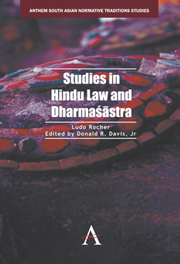Book contents
- Frontmatter
- Contents
- Foreword by Richard W. Lariviere
- Preface
- Abbreviations
- Note on the Edition
- Introduction
- PART ONE THE NATURE OF HINDU LAW
- PART TWO GENERAL TOPICS OF HINDU LAW
- PART THREE HINDU LEGAL PROCEDURE
- PART FOUR TECHNICAL STUDIES OF HINDU LAW
- Possession Held for Three Generations by Persons Related to the Owner
- The Vīramitrodaya on the Right of Private Defence
- The Technical Term Anubandha in Sanskrit Legal Literature
- The Kāmasūtra: Vātsyāyana's Attitude toward Dharma and Dharmaśāstra
- In Defense of Jīmūtavāhana
- Dāsadāsī
- The Definition of Vākparuṣya
- Janmasvatvavāda and Uparamasvatvavāda: The First Chapters on Inheritance in the Mitākṣarā and Dāyabhāga
- Karma and Rebirth in the Dharmaśāstras
- Notes on the Technical Term Sāhasa: “Fine, Pecuniary Penalty”
- Avyāvahārika Debts and Kautilya 3.1.1–11
- The Sūtras and Śāstras on the Eight Types of Marriage
- Caritraṃ Pustakaraṇe
- The Terms Niyukta, Aniyukta, and Niyoga in Sanskrit Legal Literature
- The Aurasa Son
- The Introduction of the Gautamadharmasūtra
- PART FIVE ANGLO-HINDU AND CUSTOMARY LAW
- Bibliography
- Index
The Sūtras and Śāstras on the Eight Types of Marriage
from PART FOUR - TECHNICAL STUDIES OF HINDU LAW
Published online by Cambridge University Press: 05 February 2013
- Frontmatter
- Contents
- Foreword by Richard W. Lariviere
- Preface
- Abbreviations
- Note on the Edition
- Introduction
- PART ONE THE NATURE OF HINDU LAW
- PART TWO GENERAL TOPICS OF HINDU LAW
- PART THREE HINDU LEGAL PROCEDURE
- PART FOUR TECHNICAL STUDIES OF HINDU LAW
- Possession Held for Three Generations by Persons Related to the Owner
- The Vīramitrodaya on the Right of Private Defence
- The Technical Term Anubandha in Sanskrit Legal Literature
- The Kāmasūtra: Vātsyāyana's Attitude toward Dharma and Dharmaśāstra
- In Defense of Jīmūtavāhana
- Dāsadāsī
- The Definition of Vākparuṣya
- Janmasvatvavāda and Uparamasvatvavāda: The First Chapters on Inheritance in the Mitākṣarā and Dāyabhāga
- Karma and Rebirth in the Dharmaśāstras
- Notes on the Technical Term Sāhasa: “Fine, Pecuniary Penalty”
- Avyāvahārika Debts and Kautilya 3.1.1–11
- The Sūtras and Śāstras on the Eight Types of Marriage
- Caritraṃ Pustakaraṇe
- The Terms Niyukta, Aniyukta, and Niyoga in Sanskrit Legal Literature
- The Aurasa Son
- The Introduction of the Gautamadharmasūtra
- PART FIVE ANGLO-HINDU AND CUSTOMARY LAW
- Bibliography
- Index
Summary
This is not a study of the different types of marriage described in the classical Sanskrit texts; studies of this kind are available elsewhere in the scholarly literature. This article intends to examine the sūtra and śāstra texts dealing with the forms of marriage. A variety of texts —prose and verse; dharma, artha, and gṛhya— lay down rules for the same subject-matter. What are their individual characteristics? How do they relate to one another? No definitive answers will be obtained from a restricted analysis such as this. This is only a case study, leading to a number of general observations. But if the same type of analysis is repeated for various other topics, we may hope to come to a better understanding of the nature and scope of this branch —or, these branches— of Sanskrit literature.
Ten different texts will be drawn into the discussion: four prose Dharmasūtras, one Gṛhyasūtra, three versified Dharmaśāstras, one dharma text in which prose and verse alternate, and one text on artha. They are the following:
Āpastamba (Āp) 2.5.11.17–12.2
Gautama (G) 4.4–11
BaudhĀyana (Bau) 1.11.20.2–9
Vasiṣṭha (Va) 1.30–35
Āśvalāyana (Āśv) 1.6.1–8
Manu (M) 3.27–34
Yājnavalkya (Y) 1.58–61
Nārada (N) 12.40–43
Viṣṇu (Vi) 24.19–26
Kauṭilya (Kau) 3.2.2–9
Eight of these ten texts agree in listing eight different types of marriage. The names are identical, but for one exception. Y alone includes a type called kāya, which obviously stands for the usual prājāpatya: ka is an accepted synonym for prajāpati (cf. also M 3.38).
- Type
- Chapter
- Information
- Studies in Hindu Law and Dharmasastra , pp. 587 - 596Publisher: Anthem PressPrint publication year: 2012



